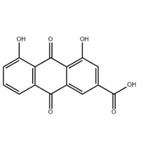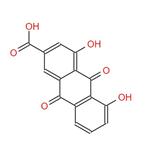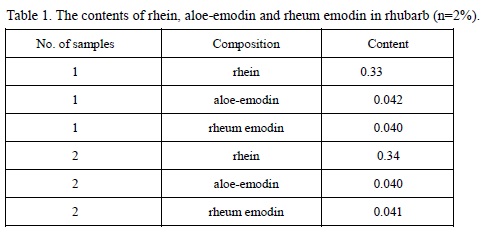- Rhein
-

- $0.00 / 1kg
-
2024-04-24
- CAS:478-43-3
- Min. Order: 0.10000000149011612kg
- Purity: ≥98%HPLC
- Supply Ability: 20tons
- Rhein
-

- $0.00 / 1KG
-
2024-04-23
- CAS:478-43-3
- Min. Order: 1KG
- Purity: ≥98% HPLC
- Supply Ability: 1000KG
- Rhein
-

- $0.00 / 20mg
-
2023-02-24
- CAS:478-43-3
- Min. Order: 5mg
- Purity: ≥98%(HPLC)
- Supply Ability: 10 g
|
| | Rhein Chemical Properties |
| Melting point | ≥300 °C (lit.) | | Boiling point | 346.72°C (rough estimate) | | density | 1.3269 (rough estimate) | | refractive index | 1.4413 (estimate) | | storage temp. | 2-8°C | | solubility | DMSO (Slightly), Methanol (Slightly) | | pka | 3.17±0.20(Predicted) | | color | Yellow to Dark Orange | | Water Solubility | <0.1 g/100 mL at 17 ºC | | λmax | 432nm(MeOH)(lit.) | | Merck | 14,8176 | | BRN | 2222155 | | Stability: | Hygroscopic | | InChIKey | FCDLCPWAQCPTKC-UHFFFAOYSA-N | | LogP | 4.290 (est) | | CAS DataBase Reference | 478-43-3(CAS DataBase Reference) | | EPA Substance Registry System | 2-Anthracenecarboxylic acid, 9,10-dihydro-4,5-dihydroxy-9,10-dioxo- (478-43-3) |
| Hazard Codes | Xi | | Risk Statements | 36/37/38 | | Safety Statements | 26-37/39 | | WGK Germany | 2 | | RTECS | CA9516000 | | HS Code | 29189900 |
| | Rhein Usage And Synthesis |
| Physical and Chemical Properties | The chemical name of Rhein is 1,8-dihydroxy anthraquinone-3-carboxylic acid, with the molecular formula C15H8O6 and the molecular weight of 284.21. It becomes yellow acicular crystal after sublimation, with the melting point 321~322 ℃ and decomposition temperature 330 ℃ and UVλmax (methanol) 229, 258, 435nm. It is soluble in alkali and pyridine, and slightly soluble in alcohol, ether, benzene, chloroform, petroleum ether, and insoluble in water. It can form red sylvine and pink sodium salt, and form a red precipitate with calcium hydroxide and barium hydroxide.
Production Method: being acquired from the hydrolysis of Rhein diacetic ester.
diethyl acetate. Uses: Current clinical treatment of rheumatic drugs often contain Rhein.
Rhein is extracted from the root of the plant Rheum palmatum L. in Polygonaceae family, which is a anthraquinones and has the functions of antibacterial, anti-cancer, cathartic, and diuretic. The contents of rhein, aloe-emodin and rheum emodin in rhubarb are listed in the following table:

Table 1. The contents of rhein, aloe-emodin and rheum emodin in rhubarb (n=2%). | | Pharmacological effects | There are chemical compounds chrysophanic acid, rhein, aloe-emodin, rheum emodin, aloe emodin, and Sennoside in rhubarb.
Both the rhein and rheum emodin have the anti-tumor effect, especially a strong inhibitory effect for melanoma and they have certain inhibition on breast cancer and ehrlich’s ascites carcinoma. When rhein was applied to intratumoral administration in mice with breast cancer, there was a significant damaging in the cancer tissue. The inhibition rate of 5mg/kg rhein and rheum emodin on murine melanoma was 76% and 73%, respectively. Rheum emodin has significant competitive inhibition on tyrosinase, and this inhibition may be one of the mechanisms why rhubarb has the anti-melanoma effect. At the concentration of 10μg/ml, Rheum emodin significantly inhibited the cell division and DNA biosynthesis of human lung cancer A-549 cells. After the subcutaneous injection of crude extracts of rhubarb, an inhibition of mouse sarcoma S37 was found. The inhibition rate of Rhein on ehrlich’s ascites carcinoma and sarcoma S180 in mice was 15% and 21%, respectively. The inhibition rate of hot water extracts of Rhubarb on sarcoma S180 in mice was 48.8%.
Rhein has inhibition effect on mouse leukemia P388. Rhein, aloe-emodin and rheum emodin are extracted from rhubarb and these three anthraquinone derivatives could minimize the amount of ascites and the number of cancer cells in different extent in mice with tumors, among which the effect of rhein was most obvious and the effect of aloe-emodin was poorer, with a almost parallel relationship with prolonged survival time. The inhibition of rhein and rheum emodin on biosynthesis of DNA, RNA and protein was stronger, whereas the inhibition of aloe-emodin was weaker. | | Uses | Medical intermediate;raw materials of health food.
| | Chemical Properties | Yellowish Brown Solid | | Uses | Rhein was used to induce necrosis-apoptosis switch in injured pancreatic acinar cells. | | Uses | Found in the free state and as glucoside in Rheum spp, Polygonaceae (rhubarb) and in Senna leaves.
A potential antioxidant resource: endophytic fungi from medicinal plants. | | Uses | Rhein is used to inhibit growth factor beta-1 induced plasminogen activator inhibitor-1 in endothelial cells. It acts as an antibacterial agent against Staphylococcus aureus. It is also used as a laxative. Further, it is employed as a pharmaceutical intermediate. | | Definition | ChEBI: Rhein is a dihydroxyanthraquinone. | | General Description | Yellow needles (from methanol) or yellow-brown powder. | | Air & Water Reactions | Insoluble in water. | | Reactivity Profile | Rhein forms a red potassium salt and a pink sodium salt. | | Hazard | Low toxicity by ingestion. | | Fire Hazard | Flash point data for Rhein are not available; however, Rhein is probably combustible. | | Biochem/physiol Actions | Constituent that is enriched in rhubarb with anti-inflammatory, anti-osteoarthritic, and anti-cancer activity. It reduces IL-1β production and secretion, caspase-3 activity, inducible nitric oxide synthase activity, and phosphorylation of c-Jun and c-Jun NH2-terminal kinase (JNK). | | Safety Profile | A poison by intravenous route. Low toxicity by ingestion. When heated to decomposition it emits acrid smoke and irritating vapors. | | storage | Store at -20°C |
| | Rhein Preparation Products And Raw materials |
|